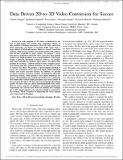| dc.contributor.author | Calagari, Kiana | |
| dc.contributor.author | Elgharib, Mohamed | |
| dc.contributor.author | Didyk, Piotr | |
| dc.contributor.author | Kaspar, Alexandre | |
| dc.contributor.author | Matusik, Wojciech | |
| dc.contributor.author | Hefeeda, Mohamed | |
| dc.date.accessioned | 2021-10-27T20:09:26Z | |
| dc.date.available | 2021-10-27T20:09:26Z | |
| dc.date.issued | 2018 | |
| dc.identifier.uri | https://hdl.handle.net/1721.1/134843 | |
| dc.description.abstract | © 1999-2012 IEEE. A wide adoption of 3-D videos is hindered by the lack of high-quality 3-D content. One promising solution to this problem is through data-driven 2-D-To-3-D video conversion. Such approaches are based on learning depth maps from a large dataset of 2-D+Depth images. However, current conversion methods, while general, produce low-quality results with artifacts that are not acceptable to many viewers. We propose a novel, data-driven method for 2-D-To-3-D video conversion. Our method transfers the depth gradients from a large database of 2-D+Depth images. Capturing 2-D+Depth databases, however, are complex and costly, especially for outdoor sports games. We address this problem by creating a synthetic database from computer games and showing that this synthetic database can effectively be used to convert real videos. We propose a spatio-Temporal method to ensure the smoothness of the generated depth within individual frames and across successive frames. In addition, we present an object boundary detection method customized for 2-D-To-3-D conversion systems, which produces clear depth boundaries for players. We implement our method and validate it by conducting user studies that evaluate depth perception and visual comfort of the converted 3-D videos. We show that our method produces high-quality 3-D videos that are almost indistinguishable from videos shot by stereo cameras. In addition, our method significantly outperforms the current state-of-The-Art methods. For example, up to 20% improvement in the perceived depth is achieved by our method, which translates to improving the mean opinion score from good to excellent. | |
| dc.language.iso | en | |
| dc.publisher | Institute of Electrical and Electronics Engineers (IEEE) | |
| dc.relation.isversionof | 10.1109/TMM.2017.2748458 | |
| dc.rights | Creative Commons Attribution-Noncommercial-Share Alike | |
| dc.rights.uri | http://creativecommons.org/licenses/by-nc-sa/4.0/ | |
| dc.source | MIT web domain | |
| dc.title | Data Driven 2-D-to-3-D Video Conversion for Soccer | |
| dc.type | Article | |
| dc.contributor.department | Massachusetts Institute of Technology. Computer Science and Artificial Intelligence Laboratory | |
| dc.relation.journal | IEEE Transactions on Multimedia | |
| dc.eprint.version | Author's final manuscript | |
| dc.type.uri | http://purl.org/eprint/type/ConferencePaper | |
| eprint.status | http://purl.org/eprint/status/NonPeerReviewed | |
| dc.date.updated | 2019-06-21T16:15:24Z | |
| dspace.orderedauthors | Calagari, K; Elgharib, M; Didyk, P; Kaspar, A; Matusik, W; Hefeeda, M | |
| dspace.date.submission | 2019-06-21T16:15:27Z | |
| mit.journal.volume | 20 | |
| mit.journal.issue | 3 | |
| mit.metadata.status | Authority Work and Publication Information Needed | |
